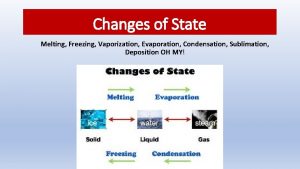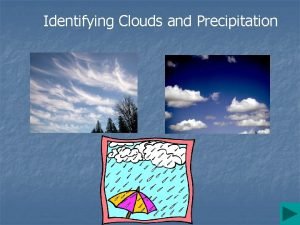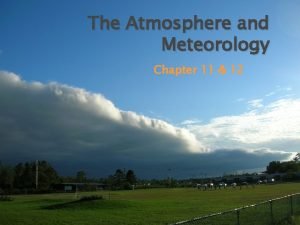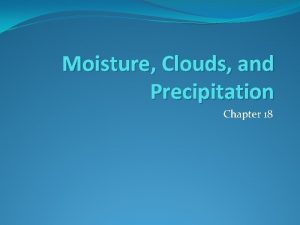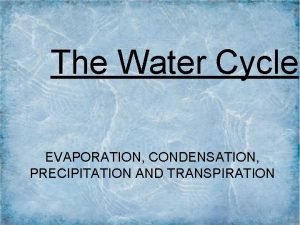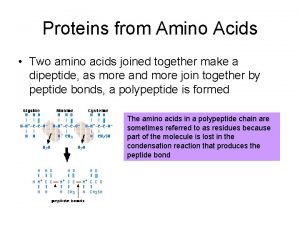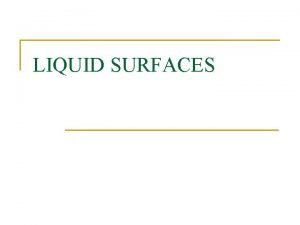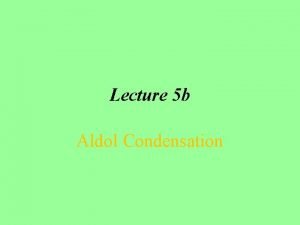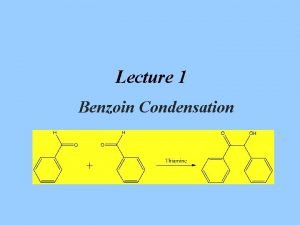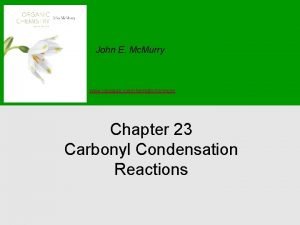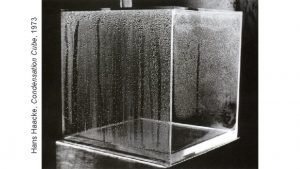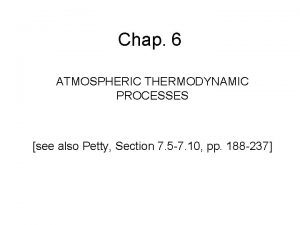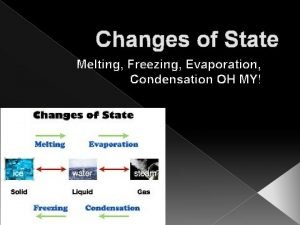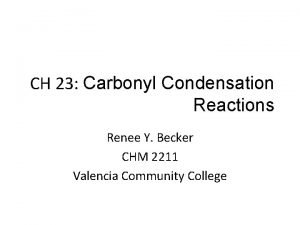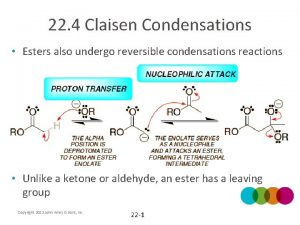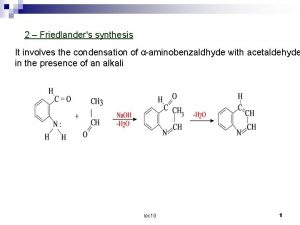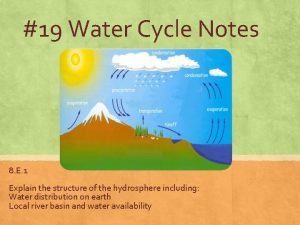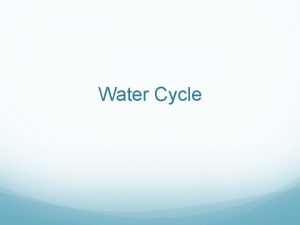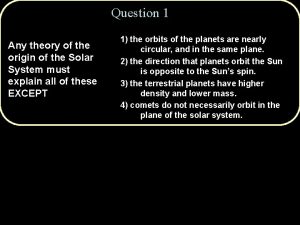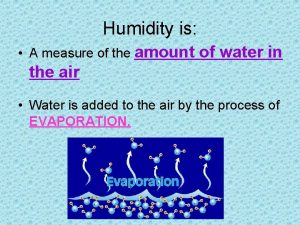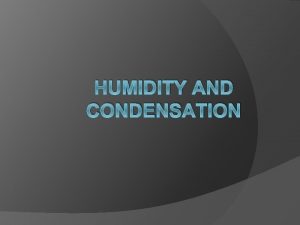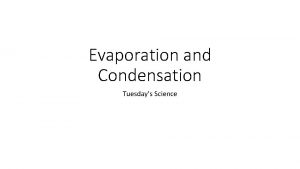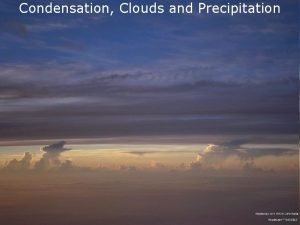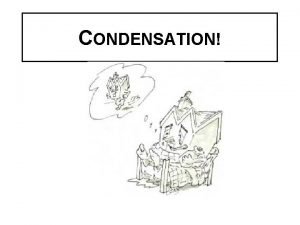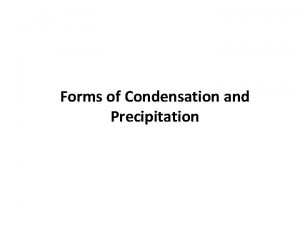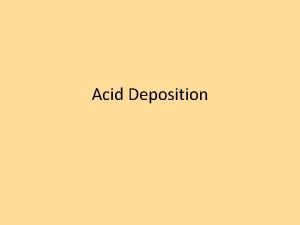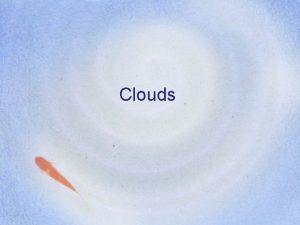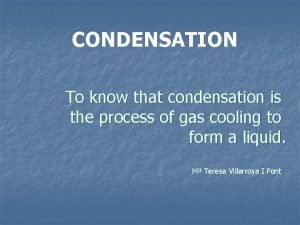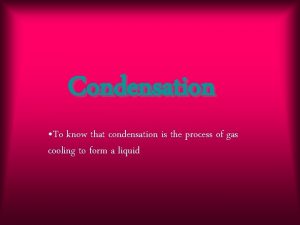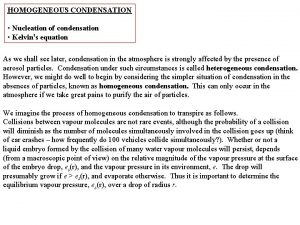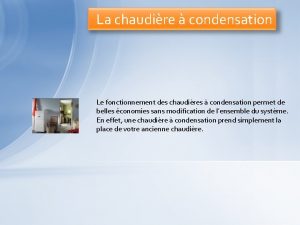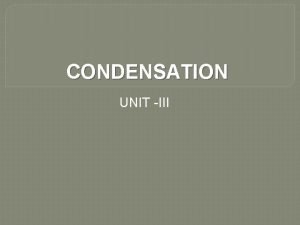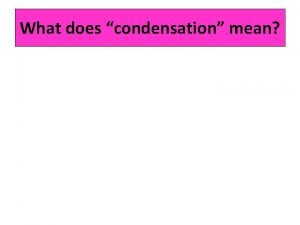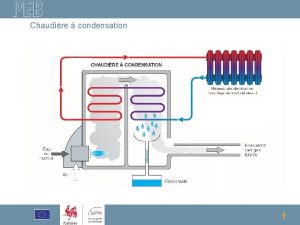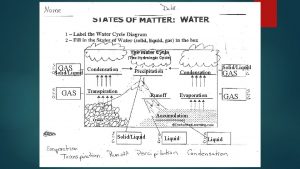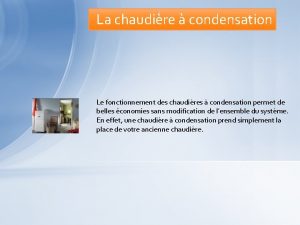CLOUDS HOW DO CLOUDS FORM Condensation or deposition














































- Slides: 46

CLOUDS

HOW DO CLOUDS FORM? § Condensation or deposition of water above Earth’s surface creates clouds. § Clouds develop in air masses that become saturated (relative humidity = 100%).

Condensation Can Form: 1. 2. 3. 4. Fog Clouds Frost Dew

Fog § When water vapor condenses on nuclei and a large # of these droplets for a mass § Minor condensation § Four Types

Radiation Fog § Outgoing radiation of Earth creates a cold ground § Air directly above surface cools to dew point = condensation

Advection Fog § Movement of warm moist air over a colder surface § Warm air is cooled = condensation § Can be persistent § “sea fog”

Upslope fog § A warm breeze ascends a mountain and cools to the dew point = condensation

Smog § Many condensation nuclei present § Can occur before dew point

WHAT CAUSES CLOUDS TO DEVELOP? § Saturation depends on: – Relative humidity of the air – Degree of cooling (has to reach dew point) – Condensation nuclei

WHAT CAUSES CLOUDS TO DEVELOP? § OROGRAPHIC UPLIFT – air forced to rise because of elevated land (mountains). § CONVENTIONAL UPLIFT – due to heating of the Earth’s surface. § CONVERGENCE OR FRONTAL LIFTING – results from the collision of air masses that have different temperature and moisture characteristics.

3 Ways Air Rises to Form Clouds Text and Photographs © 2002 Peter J. & Shirley F. Robinson

Cloud Classification § Height – Strato = Low clouds – have bases below 6, 500 ft. – Alto = Middle clouds – have bases between 6, 500 ft. and 20, 000 ft. – Cirro = High clouds – have bases above 20, 000 ft. § Shape – – – Cirrus – feather-like Stratus – horizontal, layered, gray Cumulus – vertical (heaped), “cauliflower”, unstable § Multi-level clouds – vertically thick, spanning multiple layers (nimbostratus, cumulonimbus) § Orographic clouds – distinct clouds that form via interaction between wind and mountainous terrain

High Clouds Cirrus Cirrocumulus Cirrostratus

Cirrus clouds

Cirrus Clouds

Wavy Cirrocumulus

Cirrostratus

Middle Clouds Altocumulus Altostratus

Altocumulus

Altocumulus at Sunset

Altostratus

Low Clouds Cumulus Stratocumulus Stratus Fog

Cumulus clouds over the Atlantic Ocean




Stratocumulus

Stratus Clouds

More stratus clouds

Stratus clouds: a view from above

Multi-Layer Clouds Stratonimbus Cumulonimbus


Anvil Formation

Cumulonimbus (Thunderhead)


Orographic Clouds Cap clouds Lenticular clouds






Is this a UFO?


Are these clouds?

YES! Another type of cloud can be formed from the vapor contained in the exhaust of a jet engine of an airplane when they are flying at high enough altitudes where cold temperatures cause the vapor to turn into ice crystals like cirrus clouds. These clouds are called contrails (short for "condensation trails") and look like lines in the sky.

 Particles
Particles Cloud formation
Cloud formation Three main cloud types
Three main cloud types How do clouds form
How do clouds form How does cumulus clouds form
How does cumulus clouds form Frontal cloud formation
Frontal cloud formation Clouds form
Clouds form Imbalances in earth’s heat energy help to create weather.
Imbalances in earth’s heat energy help to create weather. In order for clouds to form cooling air must be
In order for clouds to form cooling air must be Describe how clouds are formed
Describe how clouds are formed What clouds have the greatest turbulence
What clouds have the greatest turbulence Cumulonim
Cumulonim Clouds form
Clouds form Clouds form when
Clouds form when Interrogative form present continuous
Interrogative form present continuous Techniques of translation
Techniques of translation Condensation evaporation precipitation
Condensation evaporation precipitation Hydrolysis vs condensation
Hydrolysis vs condensation Condensation vs hydrolysis
Condensation vs hydrolysis Properties of amino acids slideshare
Properties of amino acids slideshare Addition polymerisation
Addition polymerisation Melting freezing evaporation condensation sublimation
Melting freezing evaporation condensation sublimation Interstitial condensation
Interstitial condensation Laplace pressure
Laplace pressure Condensation reaction vs hydrolysis
Condensation reaction vs hydrolysis Alkynes to aldehydes
Alkynes to aldehydes Thiamine catalyzed benzoin condensation mechanism
Thiamine catalyzed benzoin condensation mechanism Intramolecular claisen condensation
Intramolecular claisen condensation Condensation cube
Condensation cube Condensation copolymers
Condensation copolymers Adiabatic liquid water content
Adiabatic liquid water content Freezing melting evaporation
Freezing melting evaporation Condensation
Condensation Chm138
Chm138 Mixed claisen condensation
Mixed claisen condensation Bischler-napieralski synthesis
Bischler-napieralski synthesis Transpiration water cycle
Transpiration water cycle Hydrological cycle
Hydrological cycle Condensation sequence
Condensation sequence What is condensation
What is condensation Structure polymer
Structure polymer Particle theory freezing
Particle theory freezing Water cycle infiltration
Water cycle infiltration The condensation sequence theory explains why
The condensation sequence theory explains why Condensation
Condensation Condensation vocabulary
Condensation vocabulary Condensation
Condensation
